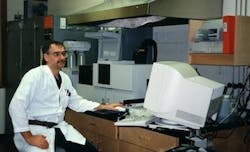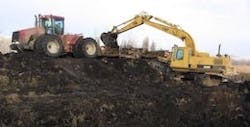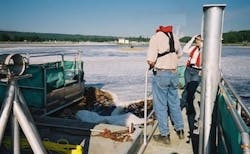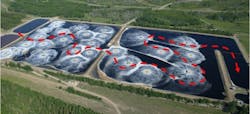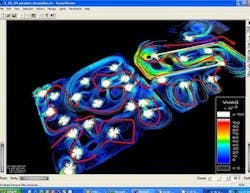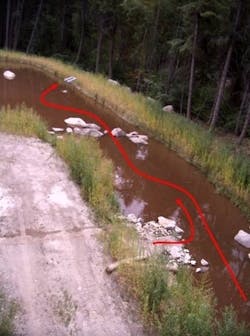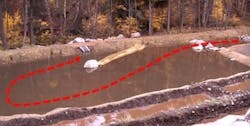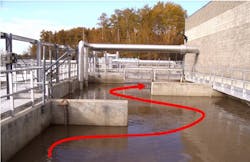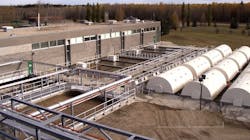What is Process Short-Circuiting For Water & How to Combat it
About the author:
Orest Protch retired in early 2020. He has operated and commissioned water and wastewater treatment plants including municipal, industrial and at remote oil camps. He was a foreman and metallurgist in an iron foundry and steel mill. In March of 2020 he put on a weeklong metallurgy seminar in Ottawa, Canada, for a special projects team of the DND, Canadian Department of National Defence.
| Photo & Figures Credits: Orest Protch |
One of the most baffling problems for process operators, engineers and supervisors to troubleshoot is that caused by system short-circuiting. The fix is almost always done by installing or changing existing baffling.
What is Process Short-Circuiting?
My simple definition of process short-circuiting is any situation where fluids and sludges of any viscosity being pumped, siphoned or moving by natural gravity or hydraulics means, take a route through the system that does not meet the calculated retention times needed.
For example, an operator will have a problem if the desired time through a system is to be 10 hours but the fluids are making it through in 1 hour.
Where Can Short-Circuiting Occur?
- Tanks of various dimensions;
- Pressure vessels;
- Wastewater treatment lagoons; and
- Retention ponds of any size.
Five Reasons Fluid Short-Circuiting is a Problem
- It can reduce the effects of any chemicals reacting with the fluids being treated.
- It can increase the amounts of chemicals being added to the system far beyond what should be added.
- It may create dead-zones in the system where no desired reactions are taking place.
- It may cause excessive particle and solids precipitation in certain system zones.
- It can increase any chemicals and particulates that should have been treated and removed in a system to reach an environmentally sensitive recipient such as a stream, river or lake.
Equation for Retention Time
Proper retention time is = System hydraulics + Chemical or Biological reaction needed + Chemical dosage (or heat)
How Fluid Short-Circuiting Occurs
With short-circuiting, the fluid or solids mixture takes the shortest route from the inlet to the outlet because gravity and hydraulics try to push the liquids in the shortest possible way to any outlet.
This also means that not all the solids may be pumped out, but some may be left sitting against the tank or vessel walls. Channels can be created inside the tank that can get very compacted over time reducing the actual internal tank or system volume.
Even an autothermal thermophillic aerobic digestion (ATAD) system can have short-circuiting and is not a normal flow through system. The fluids and solids are retained in each of the two or three pressure vessels making up an ATAD system for a programmable amount of time and then pumped to the next stage (see Photo 1).
The solution is to install another pump and piping system that recirculates the liquids and solids as they are being pumped out or to install internal wall mounted baffles. Both cause a swirling action in the tank or vessel that increase retention time.
Why Does Short-Circuiting Happen in Tanks & Vessels?
- The tank may not have been designed with hydraulics being considered.
- The tank may have been designed without taking into consideration the effects of gravity on the liquids and solids in a system. Gravity can trump hydraulics.
- Design engineers may have had a limited knowledge of how liquid and solids flow through a system.
- The system may have had baffles in the original but the as-built system does not match up with the drawings. This happens when contractors building it simply skimp on materials and labour by not installing the baffles in the first place.
How to Determine a Tank or Vessel System is Short-Circuiting
There are two ways to determine if a tank or vessel system is short-circuiting:
- Lithium or Potassium Chloride (KCl) trace, and
- Infrared camera inspection.
For industrial processes such as in pulp mills or in industrial or municipal wastewater lagoon systems. the KCl trace cannot be used as the molecule may already be found in the process.
To do a Lithium or Potassium Chloride trace, one spikes an inlet to the system with a large dose of the chemical, enough to be picked up by an Atomic Absorption Spectrometer or an Inductively Coupled Plasma Optical Emission Spectrometer (ICP-OES) (see Photos 2 and 3). One can then start collecting outlet samples and test for the tracer element.
Samples are collected every hour, or whatever is suitable for the expected retention time, and then analyzed for the trace element. If the retention time is correct then the analysis should produce an evenly distributed graph covering the entire expected retention time. If the tank or vessel is short-circuiting then the graph will be lopsided indicating that something is amiss in the system.
Another way to discover short-circuiting is with an infrared camera. These detect temperature gradients inside a tank or vessel caused by the build-up of solids on the tank floor. It is fast and reliable and easy to do. If the solids depth are not uniform on the tank bottom then this is a clue that short-circuiting is occurring.
Case Example at a Pulp Mill
Industrial lagoon systems (or aerating stabilization basins) can have short-circuiting. At the pulp mill I was at, the designed lagoon retention time was to be 28 days from inlet to outlet. The 160 acre lagoon system had frequent clean-outs, every three to five years, when it should have been every 10 years or more, as the different segments of the system had reduced depths due to settling out of solids that should have been consumed by lagoon bacteria.
Process engineers spent considerable time and money trying to prevent the solids build-up in the lagoon to meet environmental discharge license criteria for the wastewater entering the receiving river. The pulp mill pumped in 29,000 to 32,000 gallons per minute of river water.
At first the mill added baffles to the system to increase the retention time in an attempt to fix a problem they did not fully understand. It was a good start to solve the issue and it did help.
Cleaning out a pulp mill lagoon system is a very dangerous, health hazardous, time-consuming and expensive undertaking since the entire mill has to be totally shut down and bottled up. (See Photos 4, 5 & 6 above)
The lagoon had both stationary and moveable aerators and the moveable aerators were constantly being jockeyed to figure out the best location to reduce environmental issues.
They also tried moving the baffles around and finally found a setup that gave better results. The baffles decreased environmental infractions but engineers had to do better. A decision was made to do a lithium trace and it came up with a seven-day retention time, not 28 days.
The lagoon barge, used to maneuver aerators around as well as to service them, was used to collect several thousand water samples around the aerators as they were turned off and on. The pulp mill had a GPS enhancement system that the mill forestry department used for their logging operations, so this was utilized to measure the location, with an accuracy of 1 foot, where the samples were collected as well as a timestamp for each sample.
I was in the pulp mill lab at the time and we had to analyze the thousands of samples. Samples were analyzed for BOD, COD, pH, conductivity, TSS and organic/inorganic ratios. (See Photos 7 & 8 above)
A computer program (see Photo 9 above) was created and used to analyze all the sample data, with and without aerators being on or off, and a best-case position of movable aerators to stationary ones was developed in relation to the baffles. Aerators could be turned off and on as needed to maximize lagoon biological operation and 14 days was determined to be the most efficient retention. (See Photos 9 above & 10 below)
Case Example at a Municipal Water Treatment Plant
Years later I was hired to commission and operate a new water treatment plant using six dissolved air flotation units. The plant was in constant violation of the TSS discharge limits into a salmon stream. Photo 12 shows the treatment plant discharge was short-circuiting directly into the salmon stream causing TSS violations. I simply had a curtain installed to change the flow of the water through the pond to lengthen the retention time allowing the TSS to settle. (See Photo 13)
The primary settling basin of a municipal wastewater treatment plant processing 45,000 gallons per day can benefit from barriers to change the flow characteristics of a system and create the conditions needed to drop out more solids that makes the rest of the treatment process run better. (See Photos 14 & 15 at end of article)
Short-circuiting can overwhelm and negate any attempts to control a process by adding more chemicals, changing system computer control programs and yes, even firing operators and supervisors for incompetence and negligence, if environmental license limits are exceeded or the process runs poorly.
Design drawing may show baffles but the as-built system may be missing them. In one vessel that I had to do pressure vessel inspection on during a yearly shutdown (turnaround), the baffles were found to have broken their weld attachments and were sitting at the bottom of a 100 foot tall pressure vessel.
Adding or manipulating baffles goes a long way to aid in figuring out short-circuiting problems.

